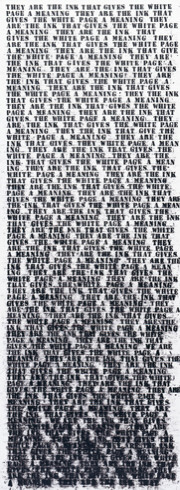“New Ways of Reading: Histories of Surface Reading” Penn Lecture
|
Last evening, Sharon Marcus (of Between Women fame), Heather Love, and Steven Best gave their lecture on the history of surface reading and the contemporary state of reading, criticism, and criticism about reading. Their talk touched on many of the same issues regarding depth hermeneutics and hermeneutics of suspicion that came up for us last seminar, so I thought it would be pertinent to share my notes here. Some context: Marcus and Best introduced a special issue of “Representations” in 2009 which focused on what they termed “surface reading,” and Love’s article, “Close but not Deep: Literary Ethics and the Descriptive Turn.” In the panel today, they addressed questions like, “What is the task of the literary critic?” “What do we do after Foucault?” and “What is the surface of the text” with their method: surface reading. Marcus had laryngitis, so Love read her presentation. Marcus was able to answer in the Q&A by projecting her typing on the computer screen (Hurrah for digital humanities!). In her presentation, Marcus makes the case for description as a viable critical method. She argues that critiques against description tautologically ends up relying on description and appeals to “accurately” capturing a text in order to make validity claims about arguments. As one example, she looks at a piece of criticism by Barthes, S/Z, a structuralist, descriptive critique of Balzac’s novella, Sarrasine that goes so far as to repeat the entirety of the novella in the appendix. Marcus illustrates how this type of description–albeit hyperdescriptive–amplifies and adds to the text, and that the “mere” act of paraphrasing or describing is no “mere” feat. I’ll paraphrase Marcus here: in order to make critical claims, critics have to know it is the same object, or aspect of the object, that they are talking about. For this, description is invaluable and inevitable. Thus, description requires critique for making assessments, and critique requires description in order to specify its object and anchor its analysis. Following that, Love argues that literary criticism needs to re-engage with empirical analysis. Like Marcus, Love traces a genealogy of hermeneutics. She uses anthropologist Clifford Geertz’s model of “thin” and “thick” description–where “thin” description is unadorned empirical analysis and “thick” description includes the many layers of human context, interpretation and affective characterization. Much of hermeneutics has focused on the “thick” description component, but Love suggests that we re-read Geertz and attend to the importance of a “thin” description, of a layer of empirical observation as well as depth-seeking hermeneutics. She quotes Geertz himself worrying that critics “in search of all-too-deep-lying turtles,[1] will lose touch with the hard surfaces of life.” Love argues that we need a criticism that is “empirical, not positivist.” Examining another point in the history of hermeneutics, Love looks at the Natural History of an Interview, where a team of social science researchers undertook an intensive examination of a 10 minute video clip. The result of this hyper-particular, “micro-reading” was 150 hours of meetings and a 700-page document. While this approach has its obvious shortcomings and is often accused of naïveté, Love suggests that this kind of detailed descriptive work resonates with the turn toward particularity in the humanities, and is one mode of working through how to read “the heard surfaces of life.” As the final perspective, Stephen Best gives a definition of surface as “that which we have to work hard to look at rather than through. Part of the problem, he suggests, lies in the complicated relationship between looking at versus reading a surface. In order to make this point, he uses two artists, Glenn Ligon and Mark Bradford, whose art/texts illustrate where the problems that occur at the boundary of such a definition. Their work (to the right) is literally made from text, ink and caulking which smears, covers, and fragment the already-fragmented text. Best argues that both “texts” speak to a systematic mode of reading text as a palimpsest–a ghostly document that has been wiped off the page and, though overwritten, shines through–illustrates the problems in depth hermeneutics. In these texts, excavation will inevitably fail because it sees the obfuscating surface as only that which must be removed. To gloss this and continue with the painting metaphor, in reading only the “erasures,” one misses the productive aspects of this kind of representation. Best and Marcus both conclude by suggesting criticism forma new ethics of how we relate to a work, rather than a politics (with its connotations of Foucauldian unearthing). [1] Read: social construction. Geertz’s, in The Interpretation of Cultures, recounts a famous story: Englishman who, having been told that the world rested on a platform which rested on the back of an elephant which rested in turn on the back of a turtle, asked […] what did the turtle rest on? Another turtle. And that turtle? ‘Ah, Sahib, after that it is turtles all the way down” |

